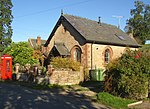New Biggin railway station
Beeching closures in EnglandDisused railway stations in CumbriaFormer Midland Railway stationsJohn Holloway Sanders railway stationsNorth West England railway station stubs ... and 4 more
Pages with no open date in Infobox stationRailway stations in Great Britain closed in 1970Railway stations in Great Britain opened in 1876Use British English from March 2015
New Biggin or Newbiggin was a railway station which served the village of Newbiggin near Kirkby Thore in Newbiggin parish, Cumbria, England. It was located on the Settle-Carlisle Line, 24+3⁄4 miles (39.8 km) south of Carlisle. Whilst the station is now disused, the line is still operational and the nearest open station is Appleby.
Excerpt from the Wikipedia article New Biggin railway station (License: CC BY-SA 3.0, Authors).New Biggin railway station
Geographical coordinates (GPS) Address Nearby Places Show on map
Geographical coordinates (GPS)
| Latitude | Longitude |
|---|---|
| N 54.647425 ° | E -2.576507 ° |
Address
CA10 1SY , Newbiggin
England, United Kingdom
Open on Google Maps







